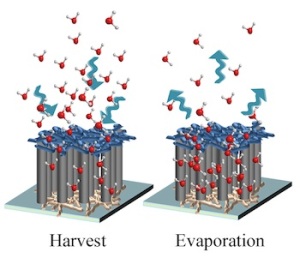Jun 12 2014
If you don’t want to die of thirst in the desert, be like the beetle. Or have a nanotube cup handy.
New research by scientists at Rice University demonstrated that forests of carbon nanotubes can be made to harvest water molecules from arid desert air and store them for future use.
 A hygroscopic scaffold created at Rice is a modified forest of carbon nanotubes that have the ability to harvest water molecules from the air. The water is stored until released either by squeezing the reusable scaffold or until it slowly evaporates back into the atmosphere. Courtesy of the Ajayan Group
A hygroscopic scaffold created at Rice is a modified forest of carbon nanotubes that have the ability to harvest water molecules from the air. The water is stored until released either by squeezing the reusable scaffold or until it slowly evaporates back into the atmosphere. Courtesy of the Ajayan Group
The invention they call a “hygroscopic scaffold” is detailed in a new paper in the American Chemical Society journal Applied Materials and Interfaces.
Researchers in the lab of Rice materials scientist Pulickel Ajayan found a way to mimic the Stenocara beetle, which survives in the desert by stretching its wings to capture and drink water molecules from the early morning fog.
They modified carbon nanotube forests grown through a process created at Rice, giving the nanotubes a superhydrophobic (water-repelling) bottom and a hydrophilic (water loving) top. The forest attracts water molecules from the air and, because the sides are naturally hydrophobic, traps them inside.
“It doesn’t require any external energy, and it keeps water inside the forest,” said graduate student and first author Sehmus Ozden. “You can squeeze the forest to take the water out and use the material again.”
The forests grown via water-assisted chemical vapor deposition consist of nanotubes that measure only a few nanometers (billionths of a meter) across and about a centimeter long.
The Rice team led by Ozden deposited a superhydrophobic layer to the top of the forest and then removed the forest from its silicon base, flipped it and added a layer of hydrophilic polymer to the other side.
In tests, water molecules bonded to the hydrophilic top and penetrated the forest through capillary action and gravity. (Air inside the forest is compressed rather then expelled, the researchers assumed.) Once a little water bonds to the forest canopy, the effect multiplies as the molecules are drawn inside, spreading out over the nanotubes through van der Waals forces, hydrogen bonding and dipole interactions. The molecules then draw more water in.
The researchers tested several variants of their cup. With only the top hydrophilic layer, the forests fell apart when exposed to humid air because the untreated bottom lacked the polymer links that held the top together. With a hydrophilic top and bottom, the forest held together but water ran right through.
But with a hydrophobic bottom and hydrophilic top, the forest remained intact even after collecting 80 percent of its weight in water.
The amount of water vapor captured depends on the air’s humidity. An 8 milligram sample (with a 0.25-square-centimeter surface) pulled in 27.4 percent of its weight over 11 hours in dry air, and 80 percent over 13 hours in humid air. Further tests showed the forests significantly slowed evaporation of the trapped water.
If it becomes possible to grow nanotube forests on a large scale, the invention could become an efficient, effective water-collection device because it does not require an external energy source, the researchers said.
Ozden said the production of carbon nanotube arrays at a scale necessary to put the invention to practical use remains a bottleneck. “If it becomes possible to make large-scale nanotube forests, it will be a very easy material to make,” he said.
Co-authors are postdoctoral researcher Liehui Ge, graduate student Amelia Hart and senior faculty fellow Robert Vajtai, all of Rice; Rice alumnus Tharangattu Narayanan, a scientist at the Central Electrochemical Research Institute, Karaikudi, India; Hyunseung Yang, a graduate student at the Korea Institute of Science and Technology and former visiting scholar at Rice; and Srividya Sridhar, a graduate student at Delhi Technological University, India, and visiting scholar at Rice. Ajayan is Rice’s Benjamin M. and Mary Greenwood Anderson Professor in Mechanical Engineering and Materials Science and of chemistry, and chair of the Department of Materials Science and NanoEngineering.
The U.S. Department of Defense and the U.S. Air Force Office of Scientific Research Multidisciplinary University Research Initiative supported the research.